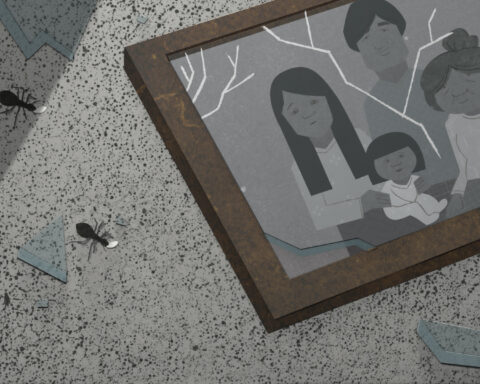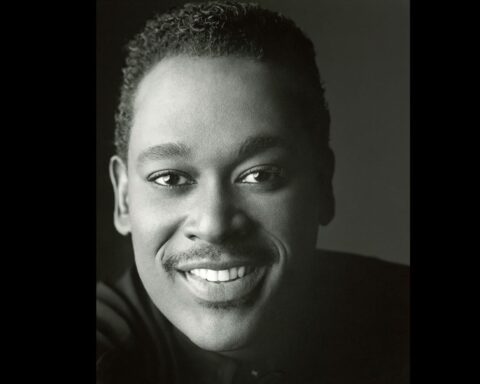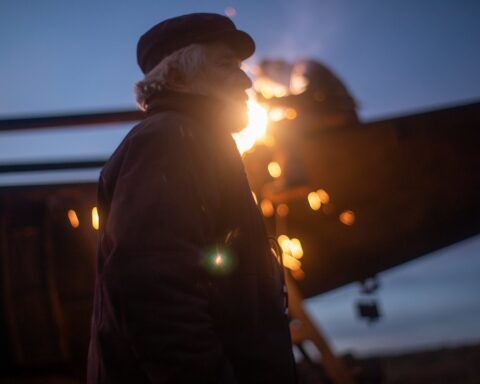Sometimes a picture burns a hole in your head, burrows into your brain and takes up residence. Like the face of the title character from the new digitally animated 3D short, Ryan.
And what a ravaged face it is, with weather roughened skin, deep creases at the mouth, one eye reddened, the other missing. And when I say missing, I mean completely missing; you can see right through the skull to the scenery behind. Whole chunks of Ryan’s face are gone, as if life had taken bites out of him. Yet, the image is impossibly real: so real, you half expect this shattered man to show up for a Q and A after the screening.
Like a Francis Bacon painting come to life, Ryan is full of remarkable images. There’s the deflated man draped over a table like a soggy pancake and the filmmaker himself with a fluorescent halo sticking out of his head. This parade of surrealist concepts have sprung from the imagination of director Chris Landreth, who has earned both his living and his reputation, for some years now, pushing Computer Graphic (CG) technology to its limits and beyond. Lots of people get labeled “cutting edge” these days, but Landreth is the real thing. And his new production is one of the most important films of 2004.
That’s a pretty bold thing to state about a 14 minute long animated film. Animated films may be important to animators and short films often showcase future promise but what puts this film in same league as the year’s best live action features?
For one thing, there’s the technology. Like it or not, digital animation, with its capacity to simulate photorealism, is becoming a force to be reckoned with, one that is already spilling over into live action, even into documentary filmmaking. And nobody is playing with CG’s potential in a more interesting and productive way than Landreth.
Then there’s the story itself, a little known Canadian mystery. The legend of Ryan Larkin, a brilliant young animator, is a tale both cautionary and terrifyingly true.
Ryan, the film, is the culmination of many years’ work, beginning in Chicago, in 1989 when Landreth first made the leap from engineering into the still developing field of computer animation. In 1994, he landed in Toronto, at Alias/Wavefront, working on the development of the now preeminent CG software, Maya. His job there was to test the software, looking for bugs, before its release on the general market.
Alias/Wavefront didn’t really care how Landreth fulfilled the assignment, so he decided to use this as an opportunity to make personal films. It was a rare situation for a young filmmaker, to have all the resources with such free rein over the content. “Of course, Alias is not a studio. If they were there would have been more checks and balances against what I was doing,” says Landreth, “If anything, I was ignored.”
Left to his own devices, Landreth made two films: the end (1995), a parody about two characters caught in their creator’s existential crisis, which received an Oscar nomination for best animated short and a darker piece about identity called _Bingo_ (1998), based on an experimental play by the same people behind the hit musical, Urinetown.
Shortly after completing Bingo, Landreth left Alias/Wavefront and before too long, went independent. In 2000, while sitting on the jury of the Ottawa International Animation Festival, he met the inspiration for his next film: a fellow jury member named Ryan Larkin. Landreth knew a bit about Larkin before the festival. “I knew of Ryan, this long haired hippie and I knew of (his film) Walking,” he says but it took the rest of that week of jury duty to piece the story together.
30 years ago, when the NFB was the centre of the animation film universe, Larkin was one of its brightest stars. He first won recognition with his groundbreaking film Syrinx (1964). Then his reputation soared when he received an Oscar nomination for Walking (1969), a haunting piece that turned the simple act of walking into visual poetry and a study of loneliness. After that there was the free flowing, metamorphic Street Musique (1972) and then there was, well, nothing…
By the late 70’s, Larkin was no longer with the NFB. Drawn into the world of addiction, he surfaced at a few commercial studios over the next few years and then disappeared. Where he had gone was a mystery. His appearance at Ottawa 2000 was the first time most people in the animation community had seen him in over 20 years and it was shocking to find out that he was living back in Montreal, surviving as a panhandler.
What a story this was, one that, after all, encompassed both what many artists wish for and what they most fear. Landreth was hooked but now, how to tell this compelling tale?
That there is a real man behind it and that his story is true was always the kicker for Landreth, who never considered making a fictionalized version. And that puts Ryan into that odd but increasingly popular category, the animated documentary. Ann Marie Fleming’s The Magical Life of Long Tack Sam is one recent example of this hybrid. American Splendor is another.
How can a film be both animated and a documentary? There are, in fact, many devices shared by both genres. Ryan uses some of the standard ones, such as still photos and film clips. This being a Chris Landreth production, however, it’s no surprise that many of his choices are decidedly non traditional. In fact, Ryan could be said to be stretching the vocabulary of all documentary filmmaking with the new tool of CG. One might even say that it is challenging the nature of documentary film itself.
In one of the film’s most charming sequences, young Ryan is brought to life with astounding plausibility, through a marriage of black and white period photos and digital animation. He dances around in all his beaded, counterculture glory and even jumps into the middle of one of his own films.
Throughout there is the voicetrack, containing actual interviews between Landreth and various subjects. This gives the film its continuity, as well as some great emotional moments. One such moment happens when Larkin reconnects with his old girlfriend, Felicity. As a key person from Larkin’s past, Landreth says, “I wanted to show her through Ryan’s eyes.” So he based the animation on sketches of Felicity which Larkin, a master draughtsman, had made many years ago, giving these scenes a completely different look than anything else in the film.
These elements combine to show different layers of Larkin’s life: his carefree youth and sketched-in old connections rendered in vivid colour or black and white, contrasting with his rather grim CG present, rendered in muted tones. It’s a very animated way to make a documentary.
And there’s more: one of Landreth’s goals was to show both outer and inner truths, to create what he calls psycho-realism. He accomplished this not only with an emotional soundtrack but also through the CG animation, which offers life like performance, and simultaneously, a very external expression of internal damage.
This is where Francis Bacon’s influence comes in. For Landreth, the distortion in Bacon’s portraits reveal a psychological reality, the not so pretty underside to people’s personalities. Landreth also looked to American artist, Ivan Albright, a contemporary of Edward Hopper and the man who created the portrait used in the film version of Dorian Gray. Albright’s portraits are realistic but still horrifying. “They show the lives that people decay into rather than the proactive, vital, immediate vitriolic aspect that Bacon exposes,” says Landreth.
With such influences at work, the concept for distorting Ryan came quickly. When they first met, Landreth saw things that were incomplete about Larkin, damaged, atrophied or just gone. Shortly after that first meeting, Landreth did a sketch from memory and rather than finish elements such as an eye or a mouth, he would cauterize them. “And it seemed to work,” says Landreth, so well that this became the first concept sketch of the project.
When it came time to animate, the scenes with Ryan demanded extra care. For one thing, they were animating a legend. And often, the emotional tone was so raw that anything less than the utmost finesse could degenerate into melodrama or insult. Like the moment where Chris hands Ryan back a piece of his head: if it wasn’t done right, the gesture would seem perfunctory, as if Chris were just handing him a Kleenex. Of course, as soon as Ryan puts the piece back in place, it flies off again, adding a note of dark humour to an otherwise emotional moment.
And there was one last, unexpected thing that had to be dealt with: Landreth’s own story. As he got deeper into the project, Landreth became aware that he had personal motives in wanting to make this particular film. He became aware that the interviews revealed as much about him as about Larkin.
Ever the explorer, Landreth built this revelation into the story by expanding his own onscreen presence. He moved beyond the protected, Michael Moore stance of on-camera judge into a more vulnerable role where his co-dependence with his subject is revealed. This mirroring of interviewer and interviewee became a major theme of the film. Landreth sums it up with an Anais Nin quote, which was a key source of inspiration: we don’t see things as they are, we see things as we are.
In the end, this film is important on many counts. Though not perfect, it’s definitely the best CG animation you are going to see anywhere for quite awhile. Yes, there is a certain lack of nuance that mars an otherwise fine piece. Some elements are too obvious. Larkin’s story is too simplified. Landreth is a brave filmmaker but perhaps he doesn’t yet totally trust himself or his audience to dig into the muck and come up with the full story. However, he is getting braver, film by film.
So we have a film, which brings a forgotten master back to public attention and, Crumb-like, sheds new light on his work. Its use of photorealistic technology is innovative and, especially in conjunction with the real life voice track, creates a tension that calls into question the whole idea of documentary in a digital age. And of course, there’s its director, who is just beginning to show his true promise. All that and a classic story of rises and falls, to boot. If that’s not a blockbuster, I don’t know what is.











